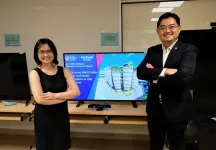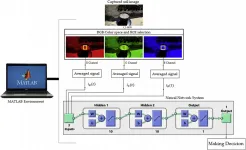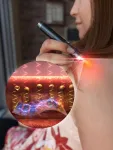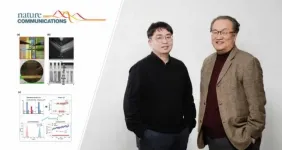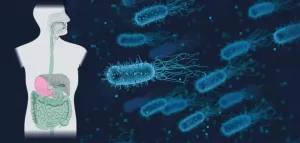Self-stacking nanocubes
2021-03-15
(Press-News.org) Copper nanomaterials with a cubic shape so perfect that they form neatly aligned stacks when brought together have been created by researchers at KAUST. The cuboid copper nanoclusters, developed by rational design, are a new member of an exotic nanomaterial family that has shown many promising properties but has remained very hard to make.
"Copper nanomaterials are a class of materials that exhibit useful properties for the fields of photoluminescence and catalysis," says Ren-Wu Huang, a postdoc in Osman Bakr's lab, who led the research. There is great interest in synthesizing new copper nanomaterials to understand how their structure influences their function.
Copper nanoclusters, which are of an atomically precise structure, are among the few copper nanomaterials that can provide such insights at the atomic level because their total structure can be determined by single-crystal x-ray diffraction. "However, the synthesis of copper nanoclusters is still a great challenge and its pace of development is slow compared to nanoclusters made from its sister metals, silver and gold," Huang adds.
In their latest work, the team aimed to make a hydrogen-rich polyhydrido copper nanocluster (PCN). "To create the cuboid-shaped nanoclusters, we added triphenylphosphine (Ph3P) to our synthesis reaction system," says Bakr. Based on previously synthesized PCN structures, the team predicted that triphenylphosphine, with its rigid conical structure, would help to create a new nanocluster with a cuboid shape.
The dark-orange block-like crystals that the team isolated from the reaction mixture did prove to be a novel PCN structure with the predicted cuboid shape. Single-crystal x-ray diffraction showed that the heart of each nanocluster contained 23 copper atoms. Surrounding this core were eight triphenylphosphine groups, forming the eight corners of the cube.
Strikingly, each dark-orange crystal consisted of multiple cuboid nanoclusters, stacked neatly together in perfectly aligned rows and columns. "We found that the subtle synergy between the cuboid shape and the intercluster noncovalent bonding interactions, such as hydrogen bonding and van der Waals interactions, is the main driving force for the unique simple cubic self-assembly of nanoclusters," Huang says.
Despite the team's latest discoveries, copper nanocluster research is still in its infancy. "Crucial questions about the growth mechanism, structure evolution and structure-property relationships of clusters are yet to be addressed," Bakr says. "We aim to shed light on those issues and to move forward with exploiting the potential of the clusters for important catalytic reactions."
INFORMATION:
ELSE PRESS RELEASES FROM THIS DATE:
2021-03-15
An interdisciplinary, multinational research team presents a new class of chemical compounds that can be reversibly oxidized and reduced. The compounds known as 'pyrazinacenes' are simple, stable compounds that consist of a series of connected nitrogen-containing carbon rings. They are suitable for applications in electrochemistry or synthesis, as the researchers describe in the science journal Communications Chemistry.
Redox reactions play an important role in our everyday life. In these reactions, one compound releases electrons and is oxidized, while another accepts ...
2021-03-15
A discovery by University of Queensland pain researchers may allow some future cancer patients, including children with leukaemia, to avoid their chemotherapy's worst and most debilitating side effects.
Professor Irina Vetter and Dr Hana Starobova thought "turning off" the inflammation that is one of the body's natural reactions to the chemotherapy drug vincristine might reduce its accompanying pain and unpleasant symptoms.
"We found the anti-inflammatory drug anakinra substantially reduced the awful nerve symptoms for which vincristine chemotherapy is known," Professor ...
2021-03-15
A study by a research team from Nanyang Technological University, Singapore (NTU Singapore) and China's first digital-only bank WeBank has found that security, service quality and system quality are the most important factors for customers who use mobile banking.
Two in five respondents (40%) said that the security they felt while carrying out transactions on mobile applications was their most important consideration.
This was followed by the level of service quality (25%), which referred to whether the banking applications could fulfil users' needs, such as carrying out transactions and easy access to credit card services.
System quality, which considers the performance of the application, including ...
2021-03-15
Researchers at UniSA have developed a cost-effective new technique to monitor soil moisture using a standard digital camera and machine learning technology.
The United Nations predicts that by 2050 many areas of the planet may not have enough fresh water to meet the demands of agriculture if we continue our current patterns of use.
One solution to this global dilemma is the development of more efficient irrigation, central to which is precision monitoring of soil moisture, allowing sensors to guide 'smart' irrigation systems to ensure water is applied at the optimum time and rate.
Current methods for sensing soil moisture are problematic - buried sensors are susceptible to ...
2021-03-15
Dr Daniel Montesinos is a Senior Research Fellow at the Australian Tropical Herbarium, at James Cook University in Cairns. He is studying weeds to better understand (among other things) how they might respond to climate change.
He said most invasive plants are characterised by their rapid pace when it comes to taking up nutrients, growing, and reproducing - and they're even faster in the regions they invade.
"New experiments comparing populations from distant regions show a clear trend for already-fast invasive plants to rapidly adapt even faster traits in their non-native regions," Dr Montesinos said.
This is further pronounced in the tropics and sub-tropics.
"Even though invasives' growth rates are already among the highest for plants, when they invade new territory ...
2021-03-15
A new concept of on-demand drug delivery system has emerged in which the drugs are automatically released from in vivo medical devices simply by shining light on the skin.
A research team led by Professor Sei Kwang Hahn of the Department of Materials Science and Engineering and Professor Kilwon Cho of the Department of Chemical Engineering at POSTECH have together developed an on-demand drug delivery system (DDS) using an organic photovoltaic cell coated with upconversion nanoparticles. This newly developed DDS allows nanoparticles to convert skin-penetrating near-infrared (NIR) light into visible light so that drug release can be controlled in medical ...
2021-03-15
An international team of researchers, affiliated with UNIST has unveiled a novel technology that could improve the learning ability of artificial neural networks (ANNs).
Professor Hongsik Jeong and his research team in the Department of Materials Science and Engineering at UNIST, in collaboration with researchers from Tsinghua University in China, proposed a new learning method to improve the learning ability of ANN chips by challenging its instability.
Artificial neural network chips are capable of mimicking the structural, functional and biological features of human neural networks, and thus have been considered the technology of the future. In this study, the research team demonstrated the effectiveness of the proposed learning method ...
2021-03-15
A chromatin-regulating enzyme has been shown by in-depth interdisciplinary investigations to be a key driver of a common type of lung cancer. Drugs that target the enzyme could improve treatment and survival rates for this particular cancer.
"Squamous cell carcinoma represents nearly one third of all lung cancers in humans," says KAUST structural biologist Lukasz Jaremko, who led the research along with colleagues at Stanford University and The University of Texas MD Anderson Cancer Center, U.S. "Our joint structural and dynamics investigations, including enzymatic activity studies, genetic analyses, and mouse model and human cell results, ...
2021-03-15
Basic, acidic, basic again: for pathogenic bacteria such as Salmonella, the human digestive tract is a sea change. So how do the bacteria manage to react to these changes? A team of researchers from the Max Planck Institute for Terrestrial Microbiology in Marburg led by Andreas Diepold has now provided a possible explanation: pathogenic bacteria can change components of their injection apparatus on the fly - like changing the tires on a moving car - to enable a rapid response.
Some of the best-known human pathogens - from the plague bacterium Yersinia pestis to the diarrhea pathogen Salmonella - use a tiny hypodermic needle to inject disease-causing ...
2021-03-15
Despite pandemic-driven restrictions on movement, there were over 12,000 accidents in Madrid in 2020, leading to 31 fatalities. In Barcelona, there were more than 5,700 collisions, causing 14 deaths. Pedestrian and vehicle safety is a priority, which is why a research project at the Universitat Oberta de Catalunya (UOC) is harnessing artificial intelligence (AI) to make decisions that will make cities safer. The researchers have looked into the correlation between the complexity of certain urban areas and the likelihood of an accident occurring there.
According to the researchers, the data they have gathered can be used to train neural networks to detect probable ...
LAST 30 PRESS RELEASES:
[Press-News.org] Self-stacking nanocubes
